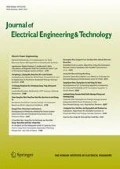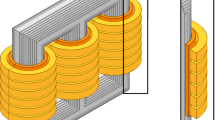Abstract
Converter transformers are widely used in the electric transport system and it is crucial equipment for the rectifier unit of the transport’s tracking substations. Leakage reactance is a crucial criterion during the development of a converter transformer. Almost all of the analytical methods consider only the axial leakage flux density during the evaluation of the leakage reactance. Radial leakage flux density is neglected in the analytical methods. Neglecting the radial leakage flux density during the computation of the leakage reactance in the two-winding transformers and other power transformers does not significantly affect the results. However, in the case of the converter transformers, radial leakage flux density also needs to be fully considered. In some of the converter transformers; windings, core, insulation material, and other parts of the transformer are so complex that analytical methods are impossible or difficult to implement. Hence, any other method is needed to evaluate the different parameters of the transformer. The optimal selection of leakage reactance is an important parameter during the design of the converter transformer. Numerical computational methods are one of the most commonly used techniques to solve and analyse the complex models of transformers. To accurately compute the leakage reactance of the electric transport system transformer (traction transformer), a transient method is used, which considers the effect of the radial leakage flux density. A prototype converter transformer of the electric transport system has been developed to obtain the experimental results. A transient method results and prototype transformer results show excellent agreement and verify the correctness of the finite element model. The results of the traditional analytical and magnetostatics finite element analysis are also compared with the short-circuit experimental test.








Similar content being viewed by others
References
Dawood K, and Kömürgöz G (2022) A simple analytical method for accurate prediction of the leakage reactance and leakage energy in high voltage transformers, J King Saud Univ Eng Sci, In Press, https://doi.org/10.1016/j.jksues.2022.06.002
Kulkarni Shrikrishna V., and Shrikrishna Khaparde A (2014) Transformer engineering: vol 1, New York: Marcel Dekker
International electrotechnical commission (2011) IEC 60076–1 Power transformers–Part 1: General
Alves BS (2019) Patrick Kuo-Peng, and Patrick Dular, “Contribution to power transformers leakage reactance calculation using analytical approach.” Int J Electr Power Energy Syst 105:470–477. https://doi.org/10.1016/j.ijepes.2018.08.044
Davood A, Bigdeli M (2014) Leakage inductance calculations in different geometries of traction transformers. Trans Electr Eng Electron Commun 12(2):28–34
Mombello EE, Venerdini GD (2018) Calculation of leakage reactance in transformers with constructive deformations in low voltage foil windings. IEEE Trans Power Deliv 33(6):3205–3210
Del Vecchio RM, et al. (2001) Transformer design principles: with applications to core-form power transformers, CRC Press
Mathieu L et al (2012) Analytical calculation of leakage inductance for low-frequency transformer modeling. IEEE Trans Power Deliv 28(1):507–515. https://doi.org/10.1109/TPWRD.2012.2225451
Rogowski W (1909) Ueber das Streufeld und den Streuinduktionskoeffizienten eines Transformators mit Scheibenwicklung und geteilten Endspulen: Die Aenderung der Umlaufzahl und des Wirkungsgrades von Schiffschrauben mit der Fahrgeschwindigkeit, Doctoral dissertation, Springer
Amin BM, Thiringer T (2014) Accurate evaluation of leakage inductance in high-frequency transformers using an improved frequency-dependent expression. IEEE Trans Power Syst 30(10):5738–5745. https://doi.org/10.1109/TPEL.2014.2371057
Rahul S, Mehta B (2021) Review on asset management of power transformer by diagnosing incipient faults and faults identification using various testing methodologies. Eng Fail Anal 128:105634. https://doi.org/10.1016/j.engfailanal.2021.105634
Peng Li, Guo P (2022) Diagnosis of interturn faults of voltage transformer using excitation current and phase difference. Eng Fail Anal 134:105979. https://doi.org/10.1016/j.engfailanal.2021.105979
Osamah A-D, Şakar B, Dönük A (2022) Comprehensive analysis of losses and leakage reactance of distribution transformers. Arab J Sci Eng 47(11):14163–14171. https://doi.org/10.1007/s13369-022-06680-1
Hernandez C, Liliana R et al (2021) Analytic formulation for the calculation of leakage reactance in wound-core transformers. Int J Appl Electromagn 65(2):197–213. https://doi.org/10.3233/JAE-190140
Yi Li, Qiuyuan Xu, Yanfeng Lu (2021) Electromagnetic force analysis of a power transformer under the short-circuit condition. IEEE Trans Appl Supercond 31(8):1–3. https://doi.org/10.1109/TASC.2021.3107799
Haijun Z et al (2013) Dynamic deformation analysis of power transformer windings in short-circuit fault by FEM. IEEE Trans Appl Supercond 24(3):1–4. https://doi.org/10.1109/TASC.2013.2285335
Zhang X, Jing, et al. (2015) Leakage inductance variation based monitoring of transformer winding deformation, In: Proceedings of 2015 IEEE 15th international conference on environment and electrical engineering (EEEIC), Rome, Italy. https://doi.org/10.1109/EEEIC.2015.7165438
He Qian et al. (2022) Identification method of transformer leakage reactance based on recursive least squares, In: Proceedings of 2022 Asian conference on frontiers of power and energy (ACFPE), Chengdu, China. https://doi.org/10.1109/ACFPE56003.2022.9952241
Dawood K, Isik F, Komurgoz G (2022) Comparison of analytical method and different finite element models for the calculation of leakage inductance in zigzag transformers. Elektron ir Elektrotech 28(1):16–22. https://doi.org/10.5755/j02.eie.29238
Kaijia T et al. (2020) Analytical calculation of leakage reactance in high-frequency transformers considering frequency-dependent and winding-structure characteristics, In: Proceedings of 2019 IEEE 3rd international electrical and energy conference (CIEEC), Beijing, China. https://doi.org/10.1109/CIEEC47146.2019.CIEEC-201983
Joseph J et al. (2021) Development of an FEM based approach for estimation of leakage reactance in multi-winding rectifier transformers and experimental verification, In: Proceedings of 2021 IEEE 5th international conference on condition assessment techniques in electrical systems (CATCON), Kozhikode, India. https://doi.org/10.1109/CATCON52335.2021.9670484
Del Vecchio RM (2006) Applications of a multiterminal transformer model using two winding leakage inductances. IEEE Trans Power Delivery 21(3):1300–1308. https://doi.org/10.1109/TPWRD.2005.860267
Longnv Li et al (2023) Design optimization of a combined shielding structure for a high impedance auto-transformer. J Electr Eng Technol. https://doi.org/10.1007/s42835-023-01422-1
Tianyan J et al (2023) Highly-efficient graphene pressure sensor with hierarchical alarm for detecting the transient internal pressure of transformer bushing. J Electr Eng Technol. https://doi.org/10.1007/s42835-022-01359-x
Kamran D, Işik F, Kömürgöz G (2022) Analysis and optimization of leakage impedance in a transformer with additional winding: a numerical and experimental study. Alex Eng J 61(12):11291–11300. https://doi.org/10.1016/j.aej.2022.05.014
Yeong LH, Park GS (2022) Power prediction of induction range considering current waveform in time-harmonic finite element simulation. J Electr Eng Technol 18:359–365. https://doi.org/10.1007/s42835-022-01252-7
Wong EW, Ming et al. (2021) Optimization design of the electromagnetic torque for surface-mounted PMSM using GA and finite element analysis for electric vehicle, In: Proceedings of 2021 24th international conference on electrical machines and systems (ICEMS), Gyeongju, Republic of Korea. https://doi.org/10.1007/s42835-022-01160-w
Acknowledgements
This work was supported by the TUBİTAK and the ITU BAP under Grant 118C109 and MGA-2020-42527 respectively.
Author information
Authors and Affiliations
Corresponding author
Additional information
Publisher's Note
Springer Nature remains neutral with regard to jurisdictional claims in published maps and institutional affiliations.
Rights and permissions
Springer Nature or its licensor (e.g. a society or other partner) holds exclusive rights to this article under a publishing agreement with the author(s) or other rightsholder(s); author self-archiving of the accepted manuscript version of this article is solely governed by the terms of such publishing agreement and applicable law.
About this article
Cite this article
Dawood, K., Kömürgöz, G. & Işik, F. Optimization and Analysis of Leakage Reactance for a Converter Transformer of the Electric Transport System. J. Electr. Eng. Technol. 19, 351–360 (2024). https://doi.org/10.1007/s42835-023-01516-w
Received:
Revised:
Accepted:
Published:
Issue Date:
DOI: https://doi.org/10.1007/s42835-023-01516-w




